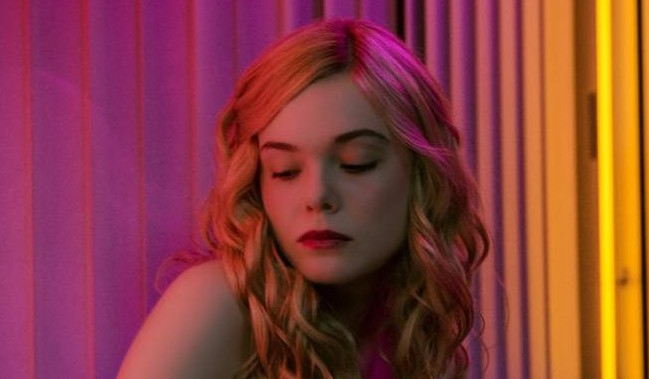
The Neon Demon DVD Review

Danish director Nicolas Winding Refn is one of the hottest director’s in the business. He is, as will become clear below the successor to the strange world of David Lynch while also being one of the most aesthetically stylish directors working. His previous films have both crossed genres and not belonged to any particular genre. Bronson (2008) is a so-called biopic of violent career criminal and prisoner Charles Bronson. Meanwhile, in Drive (2011) Ryan Gosling plays a Hollywood stuntman who also moonlights as a getaway driver for bank robbers. Gosling starred again in Only God Forgives (2013) in which he is caught in between his domineering mother and avenging the murder of his bad boy brother in underworld Bangkok. The thread running through all these films is the undercurrent of human nature and un-sublimated violence as well as the strong aesthetic composition of each frame of film and the garish wash of colour and lighting throughout, adding to the unreality of his films.
The Neon Demon represents a new level in Refn’s work, one in which he uses symbolism and metaphor in a way far beyond that in his previous films. He has taken the facile world of fashion as the root representing consumerism and artifice. The film’s protagonist is Jesse (Elle Fanning), a just turned 16-year-old innocent who has arrived from the styx to LA in the hopes that she will become a model in the fashion business. She is taken on by an agent (Christina Hendricks) who tells her to always say that she is 18. She has recently met Dean, a teenager who has taken some stylish pictures of her (in an Elizabeth Bathory type of pose with blood down her front) and is her only real and respectful friend. She is staying at a seedy run down motel in Pasadena run by equally seedy Keanu Reeves for LA’s waifs and strays. She returns home one evening to find a wild cat ravaging her room. Jesse has also been introduced to a make-artist, Ruby and a couple of shallow and fake models, making it quite clear that they are jealous of the attention others are paying on Jesse while Ruby will later have sexual designs on the girl. Jesse is soon discovering that her virginity and innocence is something of great appeal to everyone.
Behind the strange mix of horror, dreamlike imagery and the bizarre twists that take in wild cats, necrophilia and cannibalism there is a message here about the cut throat world of the industry Jesse finds herself in which consumerism takes control (without giving anything away, consumerism is also used in a literal sense) and artifice, or as fashion designer Mikey puts it, “beauty is not the only thing, it is everything” as they move in the world in which these people revolve. Without being crass, this is the world of Zoolander turned into a nightmare. But Refn has clearly shown himself not only the successor to David Lynch (with particular reference to the shallow darkness of Hollywood and LA in Mulholland Drive, 2001) but also some of the imagery of the undefinable Chilean director Alejandro Jodorowsky. Elsewhere much of the strange spartan dialogue Refn uses is reminiscent of the strange conversations in Lynch’s films such as the half heard conversations in the nightclub in Twin Peaks: Firewalk with Me (1992). Threaded through the film the electronic soundtrack by Cliff Martinez (who also provided the soundtrack to Drive) is pulsating, threatening to drown out the dialogue. Meanwhile the liberal spectres of blood and the symbolism most definitely recall Jodorowsky’s abstract surreal brand of filmmaking. There are also influences of the films of Dario Argento and Italian giallo horror films and thrillers, both in style and the use of dialogue. Clearly then Refn is creating a new style of cinema while drawing on the likes of Argento, Jodorowsky and Lynch and in doing so, like those before him strikes a hammer blow to normal convention.
Central to Refn’s vision is the cinematography by Natasha Braier – vivid, bright and blasted with colour and sharp imagery. Some of the shots of LA sunsets and nightscapes are reminiscent to a 1970s airbrush paintings of LA, while most of the characters have an almost horror fairytale look to them, often giving the impression that some of these industry insiders are vampires. In one scene one of the models, Gigi smashes a mirror after losing a walk-off to Jesse. Gigi causes Jesse to cut her hand on the glass and voraciously licks the blood off her hand. These so-called models and industry people appear here in this scene and their look as vampiric creatures of the night. Refn has stated that this is very much a film driven by women and that the images of women could not have been captured with the same subjectivity by a male cameraman. Elsewhere Refn co-wrote the film with two female writers. This is his boldest film to date and while the film might not be for all tastes it is a powerful work of art with a great performance from Fanning central to the film in an understated and doe eyed performance.
Extras on the Icon disc include interviews with Fanning, Refn and musician Cliff Martinez.
Chris Hick

